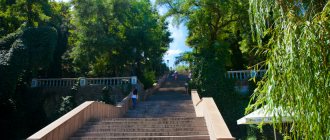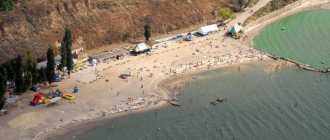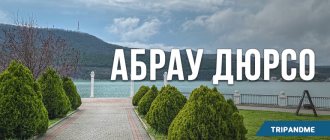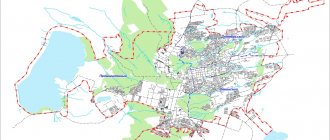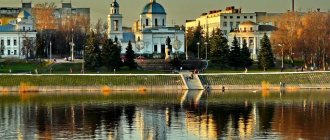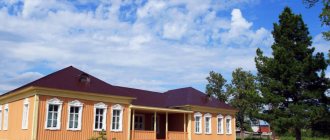Taganrog leather factory from a bird's eye view - the collapse of a giant
At the end of May this year, news spread throughout the city... the tannery was on fire! People went outside and saw how a huge flame engulfed the building, its flashes could be seen for many kilometers. Firefighters extinguished the fire for several hours.
Residents wondered what was left of the once great tannery No. 1 after the fire. The answer to this question was provided by Denis Tretyakov by shooting with a quadcopter from a bird's eye view.
The Taganrog tannery was founded in 1853. The official launch took place in 1858. The first owner of the plant was Ya. M. Serebryakov. Since 1874, the plant was owned by I. A. Scaramanga. Leather production was done by hand in dark, cramped rooms. After the creation of the Azov Leather Production Partnership in 1895, construction of a new plant began. The main building, drying rooms, warehouses, and a mechanical workshop were built. Steam heating, sea water supply, and then electric lighting were installed. The Taganrog leather factory was famous for the quality of its products and was considered one of the largest in southern Russia. His products supplied not only our country, but were also exported to England, Turkey, and Greece. At the beginning of the 20th century it was nationalized and became known as leather factory No. 1.
In the 90s of the twentieth century, the Taganrog Tannery had production facilities for processing all types of raw hides. In the manufacture of products, imported and domestic equipment, modern technological processes and chemical materials are used. It has the ability to produce a wide range of products: thin elastic chrome, yuft, hard leather, saddle leather, rawhide, velor, blanks for leather goods, feed flour, hide glue and many others. etc. The company employed up to 1,500 people.
In September 2015, an attempt was made to recognize the production shops of the defunct tannery as an object of cultural heritage and included in the unified state register. An answer came from the Ministry of Culture that work would be organized “to establish the historical and cultural value of the object” with the aim of including it in the lists of cultural heritage sites, but... they didn’t succeed, they didn’t have time, it didn’t work out.
Recently, the plant has often suffered from arson, but the last severe fire that occurred on May 25, 2022, destroyed almost everything, putting an end to the century-long history of this great enterprise. The Notepad archive contains a video of the terrible event that destroyed the plant.
Previously, we reported that the Tannery in Taganrog caught fire.
On May 25, a fire occurred at the Tannery on Kontorskaya Street in Taganrog. News on Notepad-Taganrog
Tver
Story
The history of Tver began in the 12th century - it was then that a city arose here on the site of settlements of traders and artisans.
The city received its name in honor of the Tverets River, not far from the mouth of which it was located.
Initially, Tver (or rather, the monastery) belonged to Novgorod, then the history of Tver was connected with the Vladimir-Suzdal principality.
In 1238, Tver was devastated during the raids of Batu Khan. Since 1240, the city became the capital of the Grand Duchy of Tver, thus Tver was rapidly turning into a significant cultural and political center. In particular, the history of chronicle writing in Rus' is connected specifically with Tver, and a distinctive school of icon painting has also developed here.
The XIV-XV centuries in the history of Tver is the history of a large commercial and economic city that maintains connections with the Caucasus, the Baltic states, etc.
1485 is the year of annexation of Tver to the Moscow Principality.
In subsequent years, the history of Tver was closely connected with Polish raids and the ruinous campaigns of Ivan IV.
The industrial growth of Tver was associated in the 18th-19th centuries with the construction of the Nikolaevksa railway, a little later the Kaulina textile factory opened in Tver, and in 1858 the Morozovs founded a manufactory for the production of cotton products in Tver.
During the Great Patriotic War, Tver was severely destroyed, but in the first years after the war it was possible to restore it.
Accommodation
Tver hotels are comfortable and modern hotels, which are largely located in the center of Tver.
So, you can stay in a hostel in Tver, paying from 600 rubles per day per tourist. For example, you can choose the Kalinin hostel in Tver.
In addition, tourists can choose one of the following hotels in Tver: “Akvarel” (from 3,300 rubles per day per tourist, meals - breakfast), “Oktyabrskaya” (day - from 2,600 rubles per tourist), Isaevsky Guest House (1,300 rubles per night for one tourist).
Sports and active recreation
Active recreation in Tver includes games of football and hockey, as well as cycling in Tver, as well as walking, during which tourists can get acquainted with the various sights of Tver.
Other entertainment in Tver includes City Day, which is traditionally celebrated on the last Saturday of June in Tver.
River walks are another extremely exciting activity in Tver.
Transport
Transport in Tver includes a developed bus network, tram service, water bus rides and cycling.
Bus routes connect Tver with other Russian cities - Moscow, Pskov, Novgorod, etc.
Also in Tver you can call a taxi at any of the city hotels. We draw the attention of tourists to be careful about a passenger taxi called Lucky, the quality of which caused complaints from passengers.
Shopping
Souvenirs from Tver include interesting local history publications, colorful thematic booklets, and gift books.
Tver souvenirs also include products made by folk craftsmen, in particular, those made from natural materials - wood, birch bark.
Other notable souvenirs of Tver are products from Torzhok Gold Seamstresses, as well as interesting products from a ceramic workshop called Art-Ceramic.
In addition, don’t forget about sets of postcards from Tver, as well as such popular souvenirs as keychains, cups with city views and other cute trinkets.
Hotel deals
Booking.com
How to get there
Tver railway station is located on the Moscow-St. Petersburg line. The distance from Tver to Moscow is 182 km. You can also get to Tver by train from other cities - Pskov, Smolensk, Novgorod, Vologda, etc. In addition, tourists can get to Tver by car. Travel time will be just over 2.5 hours.
First walk
For the locomotives that stand on the pedestals of the railway station with the territory of the Dzerzhinsky plant and the armored train “Ilya Muromets”, which received registration on the Vladimir highway in the PKiO named after the 50th anniversary of Soviet power, for the sake of our curiosity, no one will lay rails around the city. Life at the former airfield also comes to life only on the days of the city’s great holidays, and even then with invited airplane and helicopter crews and parachutists. Regular bus routes do not reach every corner, and traveling by taxi is not affordable for everyone. And taxi drivers are unlikely to take on the troubles of a guide. Therefore, I will allow myself to use the service of a lover of extreme activities, my good friend, a motor glider pilot under the pseudonym “Extreme”, Vladimir Aleksandrovich Bondarev .
Sparkling in the eighties of the last century on the stage of the builders' club and on tour around the region as an actor, Volodya became interested in cinema and photography. Thanks to this hobby, many of his works have been preserved in my archives in photo albums and on videotapes, which he now continues to digitize. And his passion for motor gliding and possession of a video camera, with his kind consent, lifts me with you above the surviving pieces of history from the sixteenth century to the present day.
When I flew on a plane - a maize truck, which plied between Murom and Vladimir, regular flights on airliners do not give such pleasure, then the entire flight I could not take my eyes off the window, behind which square fields, forests of the Meshcherskaya lowland, strips of roads, boxes of houses floated by. and even small dots of people. A walk on a motor glider deprives those who want to fly of the protection of an airplane cabin, and the feeling of flight becomes not imaginary, but real! You're flying! And once you get used to the state of flight, you begin to explore the world above and below you! Familiar places that have been traveled far and wide open up with new facets! The horizon moves away and you see a more detailed image of buildings, people, equipment... Details are revealed that you didn’t pay attention to while walking along the sidewalks, and from above you have the opportunity to examine in detail the object that interests you.
PHOTO Resurrection, Trinity and Annunciation monasteries
If you look from north to south, and the airfield is located in the north of the city border, the first thing that opens up is: on the left is a protective forest belt, or as we used to call it “Birch Grove”, along the former railway line Murom-2 - Kovrov, and on the right is Vladimirskoye Highway . The “Birch Grove” along the existing bypass route from Murom-1 also makes noise from the fifth kilometer towards Aleksandrovka, connecting behind the airfield with a defunct branch from Murom-2 and until recently served as the border between the city and the airfield.
We rise higher and ahead, glancing along the Vladimir highway, through the bus station, through the towering elevator, a panorama of the Southern microdistrict opens up, and on the right - Nezhilovka, Sobachaevka and by the will of people, between Sobachaevka and the military town, in the north-west of the city, the "Africa" microdistrict has grown » with the “Crocodile” store and the “Crystal” ice palace. A little further towards the horizon, where the bypass road under construction points the way, you can see the nine-story buildings of the legendary Verbovsky village, which is currently included within the borders of Murom.
But let’s turn our attention to the west and fly to the beautiful Oka.
PHOTO From Sverdlov to the 1100th Anniversary Square along Moskovskaya
A workers' village with a central hospital complex, a headquarters bridge with houses from the Stalin era, a monastery square with a monument to Peter and Fevronya, the square of the 1100th anniversary of Murom with a water tower and A.V. Ermakov, and behind the administration building there is a local history museum, located in the house of the Zvorykin merchants. The father of television, V.K., was born in this house. Zvorykin, whose monument was unveiled near his home on July 31, 2013. And all this is at arm's length. A little to the west we will see Victory Square with the beautiful Palace of Culture named after the 1100th anniversary of Murom, the building of the central bank, the Ascension Church restored after liberation from the ShRM, and a little deeper, on Karl Marx Street - the beautiful mansion of the pedagogical lyceum and the restored Sretenskaya Church.
But let’s return to the monastery square, to the Holy Trinity Women’s Monastery with the Church of Sergei of Radonezh and the relics of Peter and Fevronya, and the Annunciation Monastery, from there to go down to the Oka River.
“Whoever has not seen Murom and the Oka has not seen Russian beauty” Maxim Gorky
And indeed - babble! The panorama of the Yakimanskaya and Dmitrievskaya settlements opens up in full view, and just downstream stands the beautiful “Cable-stayed bridge”, which in 2013 emerged as the winner among Russian bridges.
PHOTO Cable-stayed bridge from the city side
And on the steep bank of the Oka, like a white swan, the Resurrection Monastery proudly rises above the river, restored after a long stay within its walls as a sports school.
PHOTO West and East
We fly upstream. Some historical monuments! St. Nicholas Embankment Church, Oka Park with a monument to the defender of Rus' Ilya Muromets. Once on this territory there was the Kremlin, the Mother of God Cathedral, and shopping arcades. The Kremlin has been destroyed by time, the cathedral was destroyed in the 30s of the twentieth century, and only a part of the shopping arcade has survived to this day.
At the Oksky Congress, a beautified embankment begins, which stretches to the Murom pier, and every time I find myself on the embankment, I am overcome with a feeling of pride that a part of my work has been invested in the improvement of this embankment. If the parapet gratings were made in the neighboring foundry shop of our plant, then the wooden frame is the work of our workshop.
PHOTO Oksky Park and Nikolo-Embankment Church
With the advent of the cable-stayed bridge, the need for a pontoon bridge became a thing of history, and now at the entrance to the pontoon bridge, annually on the day of Peter and Fevronya, the final concerts of the holiday dedicated to love and fidelity are held on the erected stage, at which even high-ranking guests of the state are present.
If the tent of the Kozmodemyanskaya Church is visible from any point on the embankment, then to the Smolensk Church, erected in honor of the victory in 1812, it is better to climb the stairs past Kozmodemyanskaya. Although from above, both churches look great.
It would be a great sin not to look into the territory of the most ancient monastery of Orthodox Rus', the Spassky Monastery. You can walk from the Smolensk Church, or you can climb up the mountain past the ancient walls from the side of the pier. Impressive! On the territory of the monastery, someone will enjoy the decoration, someone will be impressed by the history, and someone will venerate the relics of Ilya of Murom, brought from the Kiev Pechersk Lavra.
PHOTO Spaso-Preobrazhensky Monastery and Bogatyreva Mountain (Gubkin St.)
There is also something to see, learn and buy in DNT. Moreover, the corner of the monastery and the corner of the House of Folk Art, which has now become accessible to foreign guests, are located across the road.
But let's continue our way up the Oka. After all, we are in the historical homeland of the legendary hero of Kievan Rus and it will be a shame for the guests of the city that, having venerated the relics of the great monk, they did not have the strength to walk two gallops of his horse to the holy source of his name.
PHOTO Two banks on Moskovskaya: Moscow Industrial and Sberbank
The Murom port in pre-perestroika times was a busy place. Motor ships with excursionists moored regularly, and as for the hydrofoil routes, they went strictly on schedule both to Gorky and to Kasimov. The Murom textile mill “Red Ray” was also known throughout the Soviet Union. And the importance of the railway bridge across the Oka on the Moscow-Kazan route, which became double-track in the seventies and eighties of the last century, cannot be overestimated at all.
The territory of the plywood mill, which is also famous for the production of aircraft plywood, is clearly visible from above, but completely invisible from the river. But its neighbor, the “Uvarov Palace,” is clearly visible. After all, before the expropriation of the palace and its property, the building looked like a palace, and the park and stairs from the palace went down to the river itself.
Four blocks from the palace you can see the Karacharovo Trinity Church with its bell tower, and below that legendary spring from Burushka’s first leap. In total, eight Burushka skoks live in legends and eight springs bear the names of saints.
to be continued…
Ivan Vasilievich Kostin

